There are two things to remember when attending the annual Cheese Rolling event near Gloucester in England: what goes up must come down and watch the cheese - not the people chasing it. The annual event that takes place on a near vertical hillside in the village of Brockworth, Gloucestershire is an annual spectacle like none other that exists in the world. It receives international attention and is iconic of the kinds of quirky English traditions and pastimes that make the country unique.
The concept is easy: Participants in men’s and women’s categories chase a circular Double Gloucester cheese down Cooper’s Hill, near Brockworth. The seven-pound wheel of cheese is tossed into the air by the cheese master to start the competition. The cheese bounces its way down the 200-yard-long hill at a speed of 70 miles per hour while competitors chase after it rolling nearly as fast with the help of gravity. Whoever makes it to the bottom of the hill first, wins the coveted title of cheese champion.
That’s where things get interesting. Everyone from participants to onlookers and even the media attend at their own risk. Every year there are injuries that leave lasting marks long past the competition including broken legs and even some that are knocked unconscious. As brutal as the event sounds, the physical risk is part of the thrill of competing as it has been throughout the centuries of its existence.

Thousands of spectators walking uphill from the village of Brockworth to Cooper’s Hill. Photo by Anietra Hamper
The annual cheese roll on Cooper’s Hill attracts cheese fanatics, extreme sports enthusiasts, and curious onlookers from around the world. Thousands of people from all parts of England, the U.S., Japan, Canada, Switzerland and elsewhere make the pilgrimage each spring to Gloucestershire to watch the mayhem unfold. Spectators walk a mile uphill through farmland on public footpaths from the village of Brockworth just to reach the bottom of Cooper’s Hill with adrenaline building the entire way.
While the cheese rolling competition has become a thrill-seekers bucket list item, both the event, and the star of the show, the Double Gloucester cheese that it is named for, have a long history tied to this small region in England.

Men’s winner Matt Crolla holding the prized cheese. Photo by Anietra Hamper
The top cheese
It is easy to watch the Gloucester cheese rolling event and wonder why anyone would do it.
The chaos of the competition is part of the allure with the gridlock of thousands of people, cheese chants, community spirit, and a hold-onto-the-seat-of-your-pants kind of atmosphere.
Winning the top prize and the bragging rights that come with it is a big deal for those who have thought about participating, in some cases for decades.
The winner of the first men’s event, 28-year-old Matt Crolla from Manchester, England heard the roar of the crowd surrounding the hillside as he held up his cheese trophy. When asked why he did it, Crolla was quick to point out that ‘roll’ is in his name, so it was a natural attraction.
“I’ve always wanted to do it,” said Crolla. “It’s pretty incredible. I’m glad I’m conscious and have no serious injuries.”
For participants like Crolla, the cheese roll was truly a once in a lifetime event. He’s thrilled that he did it, and won, but he has no plans to do it again.
“Not a chance,” Crolla said with a laugh and sudden pain in his right shoulder that he feels as the adrenaline wears off.
Other participants, like Cooper Cummings from Washington State in the U.S. do plan to return. Cummings not only checked off a bucket list dream, but he won the second men’s race with the added excitement of beating the world champion cheese roller and local legend Chris Anderson who has won the race 23 times.
“I’m kind of hurting a little bit as the adrenaline is wearing off, but I’ve got the cheese so it’s worth it,” said Cummings. “I’m pretty pumped. I knew he [Chris Anderson] was a legend in this town, and I knew I really wanted to beat him.”
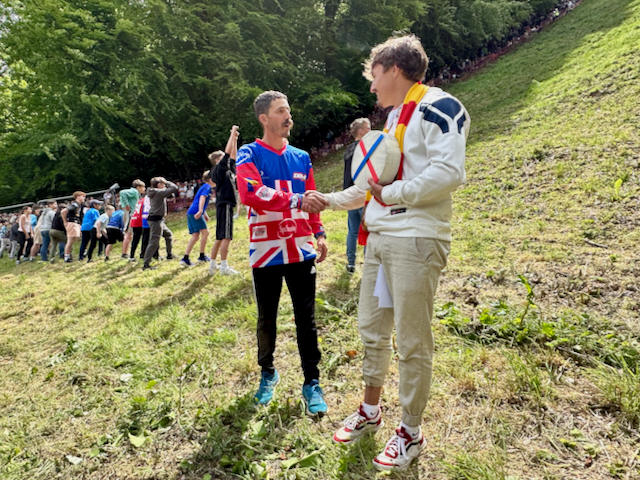
Cooper Cummings shakes hands with world cheese rolling champion Chris Anderson after taking over title – Photo by Anietra Hamper
The ceremonial handshake during the transfer of the champion cheese title was like handing off a baton in a relay race that will continue for many more centuries as long as there are participants ready and willing to carry the torch and continue this long-loved tradition.
“He deserves it,” said Chris Anderson, who at the age of 35, planned to retire and not race at all this year. “I’m getting too old, but I got to the top of the hill, and they needed more people, so I stepped in.”

Women’s race winner Delaney Irving holding up cheese trophy after being knocked unconscious. Photo by Anietra Hamper
Unfortunately, not everyone ends the competition unscathed. The winner of the women’s race, 19-year-old Delaney Irving from Canada, was knocked unconscious at the bottom of the hill sending the crowd on an emotional roller coaster. The roar of cheers when the race started abruptly chorused into a collective wincing of “oooohh,” and then silence when Irving’s hard landing knocked her out cold. Immobile and surrounded by medics for several minutes, Irving was unaware that she’d won the race.
With the same grit and determination that is required to even enter the cheese rolling competition, Irving regained consciousness long enough to hold up the cheese before she was rushed off to the hospital.
The anticipation and sheer curiosity about what might unfold at such a spectacle is part of the excitement and tradition that keeps people coming back and attracting new participants every year.
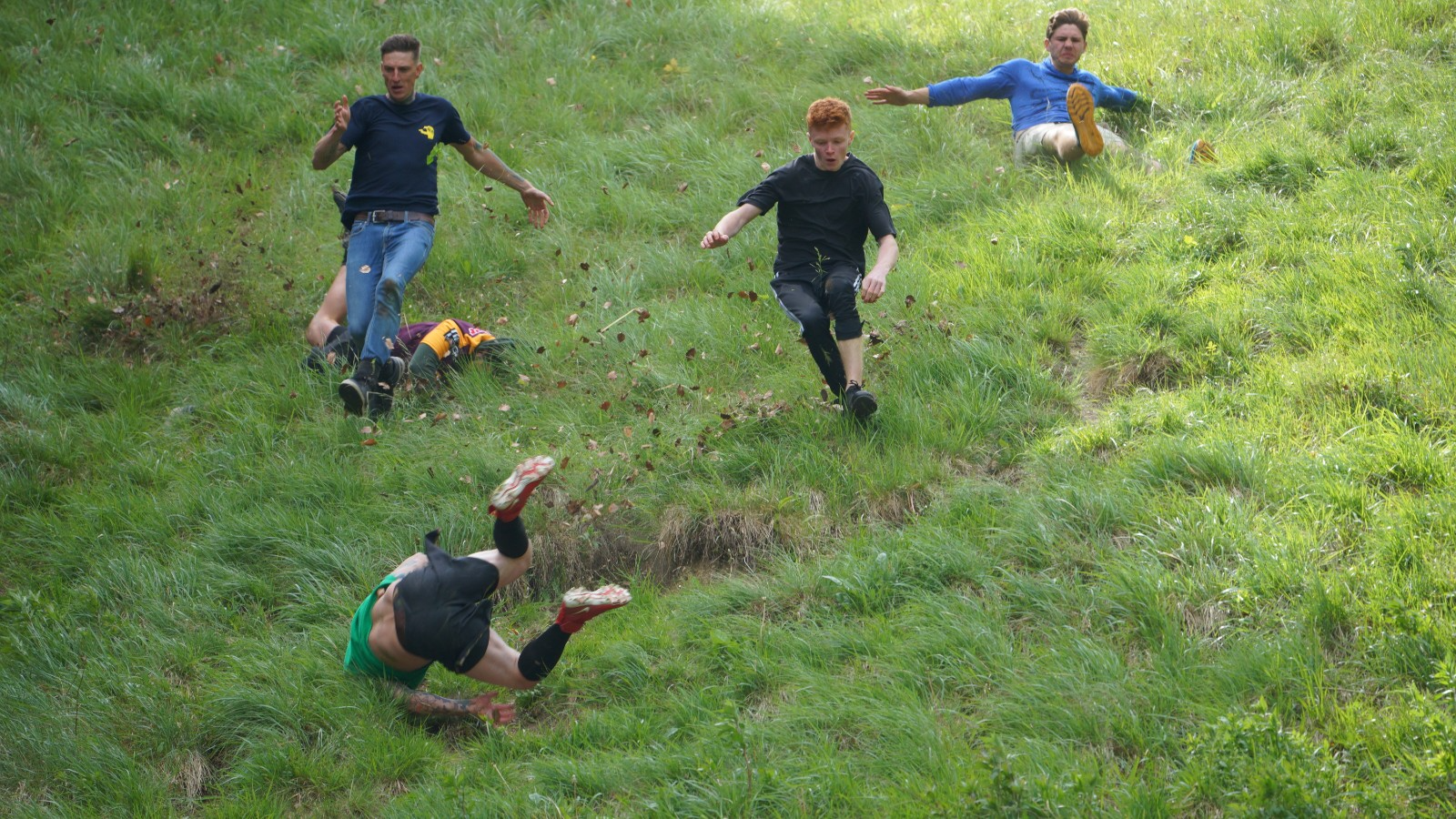
The brutal trip down Cooper’s Hill chasing the cheese. Photo by Ian Henderson
History of the Gloucester Cheese Roll
There’s something powerful and alluring about capturing a rolling wheel of cheese that makes people travel from other continents just to endure the brutality involved in even having a chance at winning it.
According to Gloucester town records, the first known documentation of cheese rolling was recorded in 1826 when the event was already a well-established tradition. It is believed that the cheese chasing likely dates back centuries, even as far as 600 years in the village. That’s a long time for the cheese tradition to age and become the event of a lifetime for those who have their eye on the prize.
The "prize" is a wheel of Double Gloucester cheese made by Smarts Traditional Gloucester Cheese Farm embellished in true champion-style with ribbons. The hard circular cheese is encased in a wooden chamber to protect it from the impact of rolling down the hill.

Children’s event on Cooper’s Hill. Photo by Anietra Hamper
The entire event takes place over the course of several hours and consists of two men’s races, a women’s race, and even children’s races for different age groups. The children race up the hill instead of down with a team of spotters shielding them from behind in case of a slip.
Those who live locally say the cheese rolling is just part of growing up here and for some, it is a rite of passage.
“It’s been something that most people from Brockworth have done and wanted to do from a child. You can speak to most people you know around here, and they’ve had a go at least once, then over time the word has spread worldwide I guess,” said Kyla Hill, one of the volunteers who helps organize the Cooper’s Hill Cheese Roll.
The thousands of spectators that line the perimeter of Cooper’s Hill must also challenge their core balance by standing for several hours on the slope of uneven ground sometimes taking added risks like climbing trees just to get a view of the action.
The ambiance surrounding the event is festive and adrenaline-filled giving a moment of fame to the winners and to the cheese behind the tradition.
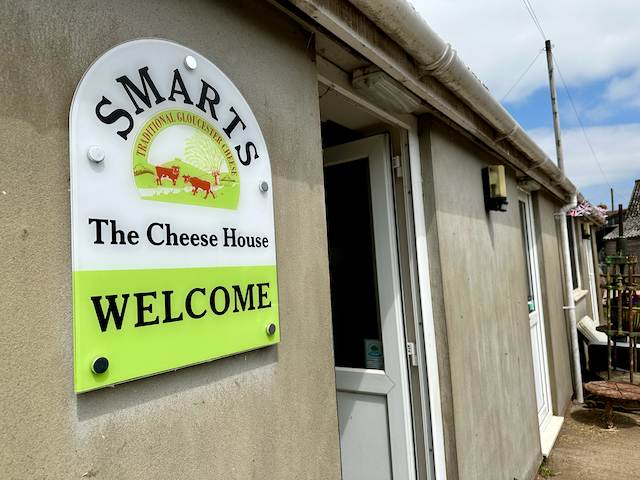
The cheese house at Smarts Traditional Gloucester Cheese Farm. Photo by Anietra Hamper
The farm behind the cheese
Just down the road from where dreams are made, chaos unfolds and lives are changed on Cooper’s Hill sits the small family farm responsible for making the famous cheese that is at the heart of this Gloucestershire tradition.
Smarts Traditional Gloucester Cheese Farm has deep roots in the region and takes cheese-making seriously. It operated as a dairy farm for 60 years before the farm’s owner, Diana Smart, took over a local cheese-making business in the mid-1980s.
“Mom had always done things with the milk like make yogurts and creams, but she didn’t know how to make cheese and she wanted to learn if she ever got the chance,” said Rod Smart who now heads operations since his mother died in 2021. “One day she got the chance to take over this business which was traditional and had been in a family for several generations. They had the traditional equipment, recipes, everything.”
At the age of 60, Diana Smart became a cheesemaker. The family built her a small cheese house on the farm that they still use today.
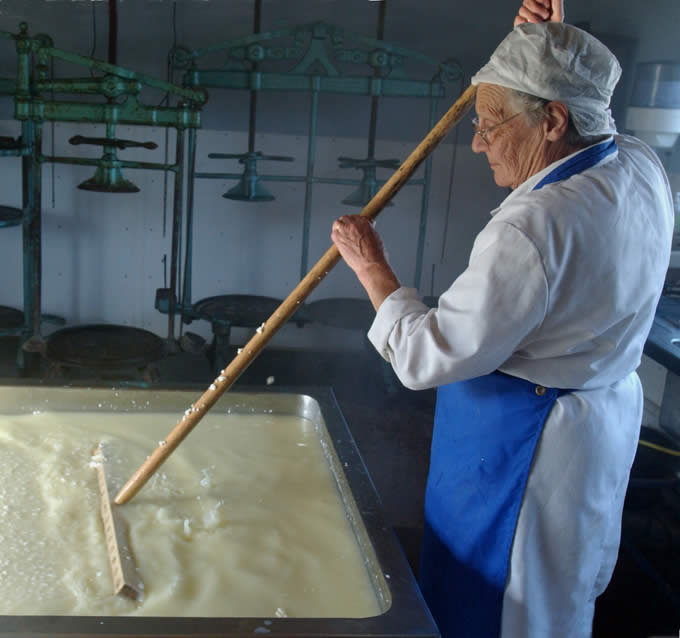
Diana Smart stirring milk in the vat still hand-making cheese into her mid-80s. Provided by Smarts Farm
What started as a curiosity for the cheese matriarch, and then a passion, became her peace and comfort after the death of her other son who first started the cheesemaking with her.
“Well into her 80s she was still in the cheese house even though she needed help lifting the blocks and even into her 90s she would trundle out to the cheese house, sit on a chair and watch us make the cheese,” said Smart.
Diana’s legacy continues today with every block of cheese that is still made by hand on the farm with the same passion and commitment to quality that was an integral part of her cheese-making process.
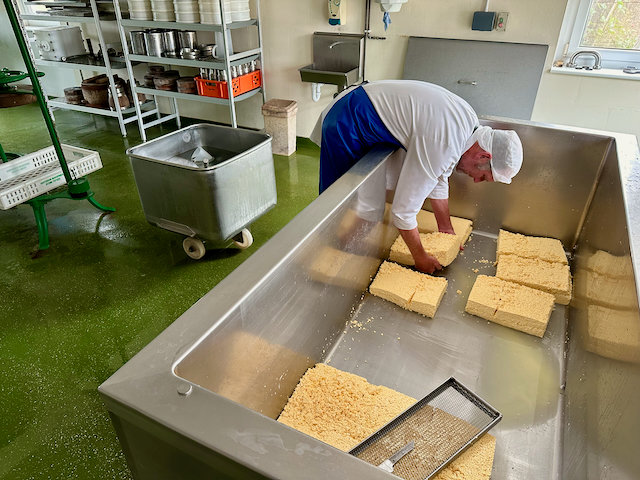
Rod Smart turning blocks of cheese. Photo by Anietra Hamper
Inside the cheese house Rod Smart stands over the stainless-steel vat manually turning large gelatinous blocks onto one another after the process of heating the milk, adding sugar and rennet, stirring, and separating the curds and whey. Once the cheese is milled, salted, put into molds, and pressed it goes into the cold storeroom where it stays for four-to-eight months depending on the type of cheese. Each step of the process is separated by minutes, hours or days before the next step can begin.
“Sure, there’s technology that could do it but you’re going to lose some integrity. One of the problems with modern cheese-making is that it became mechanized and sped up and lost a lot of its integrity. We feel that’s important to maintain as a small family farm.”
While some equipment like the vat has been updated, there are still original working machines in use like the cheese presses and a cast-iron Victorian cheese mill that was only slightly updated after a century of use.
When the Smarts bought the local cheese-making business, they had no idea that they were getting more than just a centuries-old cheese recipe but stepping into a much bigger role that came with international cheese fame.
“The cheese was being used for the cheese roll before we took it over,” said Smart. “One of the cheese rolling organizers at the time came to get their annual cheeses so suddenly we realized that not only have we got the recipes, but we inherited the cheese rolling too. Ever since, we’ve supplied the cheese.”
The spotlight also meant getting thrust into some of the cheesy politics that have surrounded the event throughout the years which was something new for the small and unassuming family farm that only ever wanted to just make cheese.
“Years ago, the cheese roll was quite small until the council and police wanted to close it down. They threatened penalties for anyone who took part or supported it. All that did was get the press involved with this cheese roll which was very local, and it went from a few hundred people turning up one year to drawing thousands the next,” Smart said with a laugh.
Eventually the Smart family embraced their newfound fame that was hidden between the lines of the cheese recipes they’d inherited. Over the years they have stepped out of the cheese house long enough to serve as honorary cheese rollers for the annual event.
“Mother rolled the cheese on at least one occasion,” said Smart. “She was scared stiff at the top of the hill, but someone hung onto her collar.”
The cheese rolling event publicity nor the technology that is available to speed up the cheese-making process to meet the demand has changed the way Smarts Farm produces its Single and Double Gloucester cheeses. It is a physically manual process that starts with milk from the farm’s herd of 70 cows that range in breeds from Gloucester, Holstein, Meuse Rhine Issel and Brown Swiss.
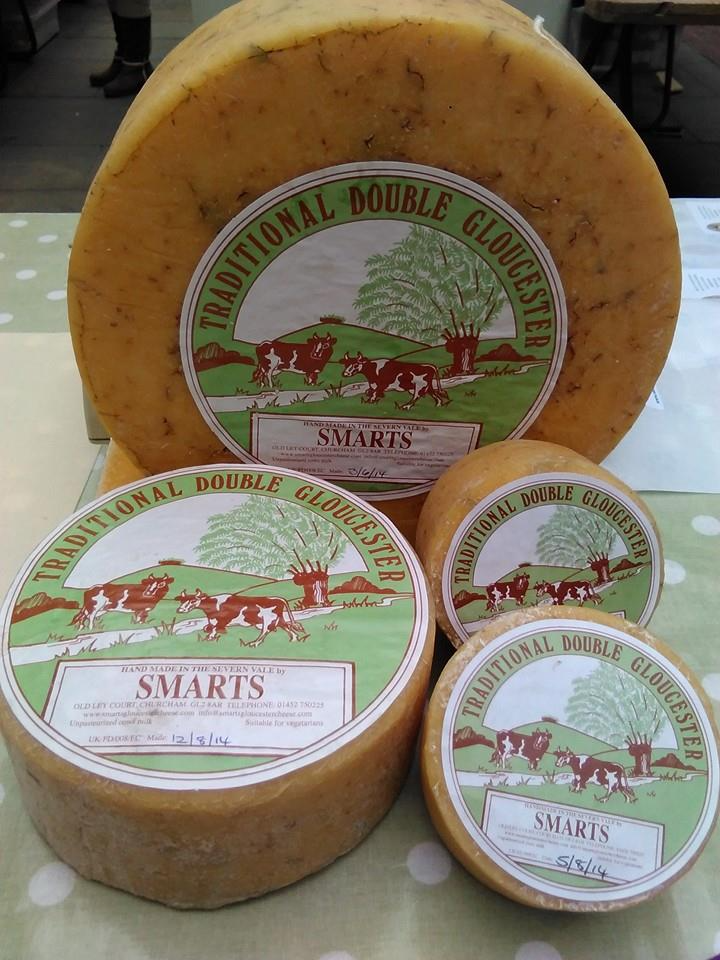
Cheese varieties made on Smarts Farm in Gloucester. Provided by Smarts Farm
The two types of cheese made on Smarts Farm are Double Gloucester, made famous by the cheese rolling event, and Single Gloucester.
The difference is that Single Gloucester cheese is made from half skim milk and half whole milk whereas Double-Gloucester contains all whole milk. They also differ in the heating process.
Another significant difference in the cheeses is that you can only get Single Gloucester cheese in Gloucester from one of the few independent farmers who make it because there is a protection placed on it.
“It can only be made in Gloucestershire with certain stipulations,” said Smart. “You must have Gloucester cattle in the herd, the milk has to come from Gloucestershire [meaning straight from the farm], and a traditional recipe.”
Diana Smart played an important role in protecting the Single Gloucester cheese. In the late 1980s and early 90s she and another local farmer fought to keep the cheese local to the dismay of a mass producer. In the end, the small local farmers won the protection which gives a point of difference to the few farms that still make it and sell it locally.
“There are only a few traditional single-Gloucester recipes around. Every farm that made it had its own recipe, so you have to be lucky to either have inherited a recipe as we have or find someone who has a copy and is willing to share it,” said Smart.
Single Gloucester cheese was originally made to feed the farmers and the work hands. It doesn’t travel well, so it never did, which kept it unique to Gloucestershire. During the industrial revolution people traveled off the farms and into the cities so the cheese making declined in the countryside. Double Gloucester was more easily transportable, therefore more easily copied by manufacturers who got ahold of it.
A new cheese variety has emerged in recent years that the Smarts call Vintage Gloucester. It emerged after the COVID pandemic when the cheese had to sit on the shelves for an extended period, but it remains a popular new offering for cheese fanatics.
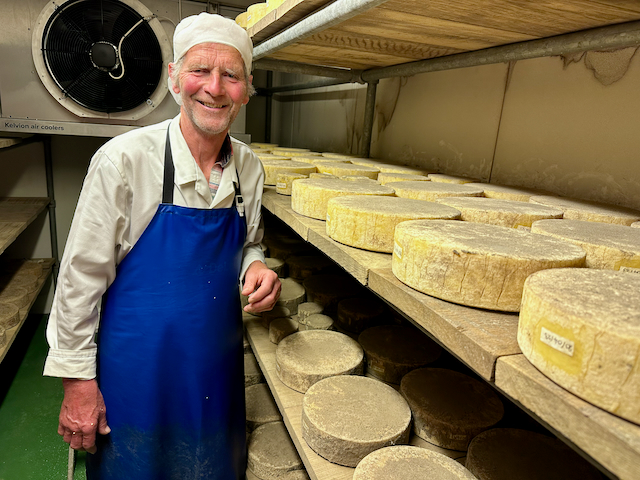
Rod Smart stands in the cheese refrigerator. Photo by Anietra Hamper
Though the Smarts Traditional Gloucester Cheese Farm gets its five minutes of international fame each year with the cheese roll, nothing changes day-to-day for the small family business that maintains its quiet presence in the Gloucestershire countryside. When the cameras turn off from the event, the broken bones are healed and the thousands of visitors go home, the Smarts will still be turning the cheese until next year when it rolls again, maintaining their humble and integral part in the tradition of cheese rolling and cheesemaking in this tiny region of England.
